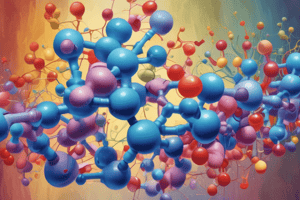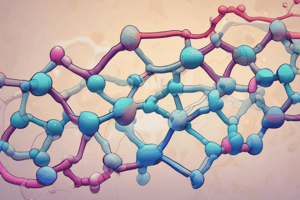Podcast
Questions and Answers
What is the general structure of an amino acid?
What is the general structure of an amino acid?
- Carboxyl group, amino group, and a side chain (correct)
- Ketone group, amino group, and a side chain
- Aldehyde group, amino group, and a side chain
- Hydroxyl group, amino group, and a side chain
Which amino acid has a secondary amine instead of a primary amine at the α-position relative to the carboxyl group?
Which amino acid has a secondary amine instead of a primary amine at the α-position relative to the carboxyl group?
- Proline (correct)
- Valine
- Methionine
- Alanine
Which stereoisomer configuration are all amino acids derived from proteins in terms of their α-C atoms?
Which stereoisomer configuration are all amino acids derived from proteins in terms of their α-C atoms?
- L-stereochemical configuration (correct)
- D-stereochemical configuration
- R-stereochemical configuration
- S-stereochemical configuration
Which type of amino acids are classified based on polarity?
Which type of amino acids are classified based on polarity?
Why is glycine considered achiral in terms of its stereochemistry?
Why is glycine considered achiral in terms of its stereochemistry?
What instrument is used to measure the direction and angle of rotation of polarized light by amino acids?
What instrument is used to measure the direction and angle of rotation of polarized light by amino acids?
What is unique about cysteine among the 20 amino acids?
What is unique about cysteine among the 20 amino acids?
What is the metabolic fate of glucogenic amino acids?
What is the metabolic fate of glucogenic amino acids?
Why are nonpolar side chains in polypeptides associated with each other rather than with water?
Why are nonpolar side chains in polypeptides associated with each other rather than with water?
Which type of amino acid cannot be synthesized within the human body?
Which type of amino acid cannot be synthesized within the human body?
What structural feature allows cysteine to form disulfide bonds?
What structural feature allows cysteine to form disulfide bonds?
What is the metabolic fate of ketogenic amino acids?
What is the metabolic fate of ketogenic amino acids?
Which of the following amino acids is classified as an uncommon amino acid?
Which of the following amino acids is classified as an uncommon amino acid?
What is the correct order of amino acids in the pentapeptide Ser-Gly-Tyr-Ala-Leu?
What is the correct order of amino acids in the pentapeptide Ser-Gly-Tyr-Ala-Leu?
What type of bond is formed between two amino acids in a peptide?
What type of bond is formed between two amino acids in a peptide?
Which of the following amino acids is a derivative of tyrosine and plays a role in regulating metabolism?
Which of the following amino acids is a derivative of tyrosine and plays a role in regulating metabolism?
What is the stereochemistry of the α-carbon in amino acids?
What is the stereochemistry of the α-carbon in amino acids?
What is the three-letter abbreviation for the amino acid leucine?
What is the three-letter abbreviation for the amino acid leucine?
Flashcards are hidden until you start studying
Study Notes
Amino Acid Structure
- Amino acids are composed of a carboxyl group (COOH), an ɑ-amino group (NH2), and a side chain (R) that affects the protein's 3D structure and characteristics.
- Except for proline, all 19 proteinogenic amino acids have a primary amine at the ɑ-position relative to the carboxyl group.
Stereochemistry of Amino Acids
- All amino acids recovered from polypeptides, except glycine, are optically active, meaning they rotate the plane of polarized light.
- The α-C atoms of amino acids (except glycine) are asymmetric centers, making them optically active.
- Glycine is not optically active because it has two H atoms attached to its α-C atom, making it superimposable on its mirror image.
Classification of Amino Acids
- Amino acids can be classified based on polarity (non-polar, polar uncharged, and polar charged).
- They can also be classified based on chemical behavior of the side chain (aromatic, aliphatic, basic, or acidic).
- Amino acids can be classified as essential or non-essential based on nutrition.
- They can also be classified based on metabolic fate (glucogenic and ketogenic).
Neutral, Basic, and Acidic Amino Acids
- Neutral amino acids are classified based on their side chain properties.
- Basic amino acids have a positive charge, while acidic amino acids have a negative charge.
- Cysteine is unique due to its thiol group, which can form a disulfide bond with another cysteine.
Essential and Non-Essential Amino Acids
- Essential amino acids cannot be synthesized in the human body and must be present in the diet.
- Non-essential amino acids can be synthesized in the body.
- Some amino acids are required to some degree in young, growing animals and/or during illness.
Glucogenic and Ketogenic Amino Acids
- Amino acids degraded to pyruvate, α-ketoglutarate, succinyl CoA, fumarate, and/or oxaloacetate can be converted to glucose and glycogen, making them glucogenic.
- Other amino acids are ketogenic, meaning they are degraded to acetyl CoA or acetoacetate.
Uncommon Amino Acids
- Citrulline is a non-proteinogenic amino acid that plays a role in the urea cycle.
- Other uncommon amino acids include neurotransmitters and hormones, such as thyroxine.
Peptide Structure
- A peptide bond is formed by condensation, linking two amino acid molecules through a substituted amide linkage.
- Peptides can be displayed with the amino-terminal end on the left and the carboxyl-terminal end on the right.
Studying That Suits You
Use AI to generate personalized quizzes and flashcards to suit your learning preferences.




